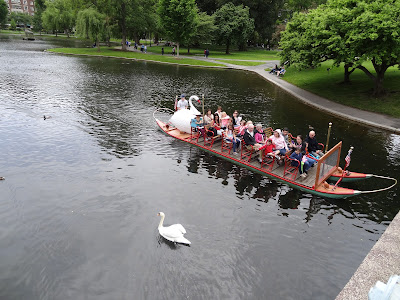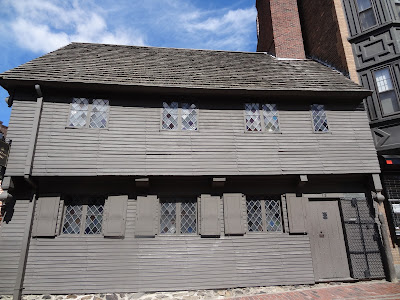Visited: June 2017
Nearby city: Boston, MA
“By the rude bridge that arched the flood,
Their flag to April’s breeze unfurled,
Here once the embattled farmers stood,
And fired the shot heard round the world.”
-from “The Concord Hymn” by Ralph Waldo Emerson, 1837
In the latter-half of the 18th century, tensions between the United Kingdom and its American colonies, particularly the Province of Massachusetts Bay, had been building and growing. In the 1760s, a long conflict with France, the Seven Years War (known as the French and Indian War in the colonies), had put the British government deeply in debt. British Parliament passed a series of measures designed to increase tax revenue from the colonies, such as the Stamp Act and the Townshend Acts. Parliament felt that since colonists living in America were subjects of the British crown, they should be expected to pay their share to support and maintain the British Empire. Colonists countered that such taxes were unfair, because they did not (and could not) elect any representatives to Parliament. James Otis, a Boston lawyer and politician, succinctly summarized the argument in the phrase “taxation without representation is tyranny.” Over the years, that argument caught on with many living in the colonies, particularly in Boston and the surrounding countryside. Tensions boiled over during the Boston Massacre in 1770 (see the previous post on Boston Historical Park for more info on the massacre: https://paulnationalparks.blogspot.com/2020/07/boston-national-historical-park.html)
This unrest led Samuel Adams, another Boston politician, to organize the Sons of Liberty, a secret group dedicated to opposing British taxation policy, advancing rights of colonists, and ultimately independence from the Crown itself.
In 1773, British Parliament, in an attempt to save the struggling British East India Company from bankruptcy, passed the Tea Act. The Act allowed the Company to have a monopoly on tea sales in all of the colonies. On the night of December 16, 1773, in an act of protest, the Sons of Liberty, some disguised as Mohawk Indians, boarded three British ships laden with the Company’s tea. The colonists then proceeded to dump 342 chests of tea (worth $1.7 million dollars in 2020) into the depths of Boston Harbor.
Parliament’s reaction was swift and severe. The Coercive Acts (dubbed the “Intolerable Acts” by the colonists), completely closed Boston Harbor until the colonists paid for the destruction, almost all local political offices in the colonies would be appointed by Parliament, town meetings were limited to only once a year, it allowed the Royal Governor to order trials of British officers stationed in the colonies to take place back in Britain, and it also allowed the Royal Governor to quarter soldiers in people’s homes. These laws had a severe impact on the economy and stripped the colonies of a certain level of autonomy that they had enjoyed for the past century. Under these laws, the newly appointed Royal Governor, Thomas Gage, quickly dissolved the local colonial assembly.
For many patriots in the Massachusetts colony, the Intolerable Acts were the last straw. It was time to make the bold move, and declare independence. The open rebellion began when the local assembly simply ignored Gage’s order dissolving it, and continued to meet in the small town of Concord a few miles northwest of Boston. John Hancock served as President of this de facto governing body, now known as the Massachusetts Provincial Congress. In February 1775, the British Parliament declared Massachusetts to be in a state of rebellion. The Provincial Congress called on townsfolk to form militia and to be prepared for hostilities. Members of the local militia came to be known as “Minutemen,” because they were expected to be ready for an attack by the Redcoats at a minute’s notice. These local militias were self-trained soldiers, a ragtag group of farmers, laborers, and artisans. Common everyday folk.
In April 1775, 700 British Army regulars, under command of Lt. Col. Francis Smith, were preparing to march to Concord with orders to destroy military supplies stored there by the rebel militia. Patriot intelligence was able to discover a few weeks beforehand about the planned march. They were able to move some (but not all) of the supplies to other locations. Upon a signal of a lantern placed in the tower of the Old North Church (one if by land, two if by sea), Paul Revere and other Sons of Liberty would ride out to the militia in Concord, warning everyone along the way that the British Army was approaching. This famous “Midnight Ride” happened on April 18, 1775.
The British Army met armed militia on the early morning of April 19, 1775 in the small village of Lexington (approximately halfway between Boston and Concord). Not so much a battle, it was more of a skirmish. Shots were exchanged and 8 Minutemen were killed. The British suffered only one casualty. Greatly outnumbered, the Minutemen fell back and retreated about five miles to Concord. The British Army reached Concord and was able to destroy the supplies, gun carriages and a cannon stored in a farm owned by a James Barrett. The British surmised that as word had got out of their advance, that more supplies would be found scattered around the countryside. The British army split up to search for more supplies and weaponry to destroy or confiscate.
A group of about 100 British Army regulars reached the Old North Bridge, north of Concord. There they were met by 400 Minutemen, as a dozen local militias had amassed together.
The militia were ordered not to fire until fired upon, but they were ordered to advance. The British guarding the bridge were ordered to retreat across to the other side of the bridge and hold their ground. When the militia had got about 50 yards from the Army, a shot rang out. It’s unclear who exactly fired the first shot, it was likely a warning shot fired by a panicked British soldier. A few more volleys followed, despite their being no order to “fire.” Two Minutemen who were leading the line marching to the bridge, fell and died instantly. At that point, militia commander Major John Buttrick yelled out “Fire, for God’s sake, fellow soldiers, fire!”
The revolution had begun.
Overwhelmed by the initial onslaught of the Minutemen and realizing they were vastly outnumbered, the British army at the Old North Bridge fell back and began a tactical withdrawal. As the British Army retreated out of Concord, they were constantly harassed by the guerrilla tactics of the Minutemen, firing in seclusion along the roads, in the brush, in the trees, behind the fences and walls, inside barns and homes. Incredibly, the mighty British were being routed. By the time the Redcoats reached Lexington on their retreat, they were reinforced by Brigadier General Hugh Percy with nearly 1,000 men. However, at that point the orders were clear: cut losses and continue the tactical withdrawal to Boston.
The Army eventually made it back safely to Boston, but with the Minutemen in pursuit the whole way. Outside of town, the militia constructed defenses and began to lay siege (*which the British were able to lift at the Battle of Bunker Hill - see last week’s post for further details*). By the end of the fighting, the Americans had 49 dead and 39 wounded, but the British suffered more with 73 dead and 174 wounded.
The colonists were frankly stunned that they had been able to drive the powerful British Army off the field of battle. And now that open hostilities had occurred between the armed militia and the British regular army, they realized that there would be no turning back and no compromise. For many living in the colonies, independence would be the only resolution to the war. John Adams, who had been somewhat reluctant to support armed revolution, realized that there would be no other way at this point and commented that “the Die was cast, the Rubicon crossed.” Thomas Paine, a passionate advocate for self-rule, upon hearing news of the battle rejoiced that the colonies had “rejected the hardened, sullen-tempered Pharaoh of England forever.”
Indeed, the battles at Lexington and Concord eventually led the colonies to establish their own independence. A nation bereft of monarchy and founded on the principles of representative democracy, a constitutional republic guaranteeing unalienable rights, freedom, and equality for all mankind, ever striving to become a more perfect Union. The reverberations of this brazen experiment led to similar popular revolutions all over the globe. The little militia on the hills outside of Boston had truly fired the “shot heard round the world.”
Today this hallowed ground is preserved as the Minute Man National Historical Park. The highlight is the field of that first confrontation in Concord at the Old North Bridge. The bridge there today is a replica of the original, which had been torn down and replaced in 1788, built in 1956.
Here you will also find the Minute Man statue, which captures the spirit, tenacity, and resolve of these brave rebels, who put down their plow to take up arms against tyranny and fight for freedom, independence, and liberty. It was sculpted by Daniel Chester French in 1874. The podium of the statue is inscribed with Emerson’s famous stanza from the “Concord Hymn.” It is a beautiful statue and a place that everyone should visit.
Unfortunately, we were short on time and only stopped at this battlefield, which is just one small part of the larger park. The Park also contains a number of other historical sites: The Wayside - the home of Minuteman leader Samuel Whitney and later the home of authors Louisa May Alcott, Nathaniel Hawthorne, and Margaret Sidney; Lexington Battle Green, Barrett’s Farm, Hartwell Tavern, the spot where Paul Revere was captured during his “Midnight Ride”, and the five-mile “Battle Road Trail” which connects Lexington with Concord and approximates the route of the British’s withdrawal while skirmishing with the militia. There are also plenty of ranger programs, and we got to see some re-enactors (British and Patriots) 😀 in character at the Old North Bridge.
Tara and I were so thrilled to visit this place of monumental importance to American history, and cannot wait to go back and visit again. For more info: https://www.nps.gov/mima/index.htm















































































